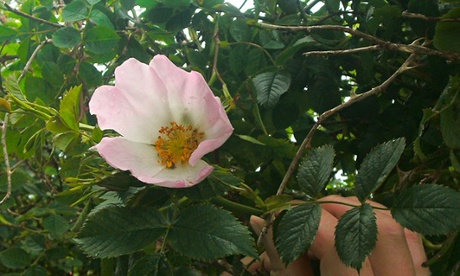
My earliest foraging memory is a summer one. On a blistering post-school afternoon, I found a plant on waste ground. Curiously, it looked like mint but had the smell and taste of lemon: lemon balm. Summer is when many plants attract pollinators so they can produce fruit and propagate. So we get gorgeous flowers, many of which are edible and very tasty.
If you take responsibly, your bounty is sustainable and free. Please only take what you are confident you can positively identify: if in doubt; leave it out. Use a good guide to help you such as Alys Fowler's The Thrifty Forager, or the Collins Gem version of Richard Mabey's Food for Free. Only pick what you can comfortably use without waste or harm to the plant – leave some for others. Wash your bounty and check for bugs lurking in flowers.
Lemon balm (Melissa officinalis)
These have oval leaves, that are hairy with toothed edges. The leaves are opposite on a square, branched stem that grows to about 1m in late summer. They smell distinctly of lemon when crushed. It has small, two-lipped white/yellow to pink flowers in small clusters which bees love.
Pick the top young leaves. The older leaves are more tough and harsh. Use raw in salads; to make pesto (recipe below); chop to flavour mayonnaise, ricotta and cream cheese (lovely stuffed under a chicken breast skin); to infuse in vinegar or custards, or to make a tea; and bruise to flavour wine cups and punches. Use the stems and older leaves on the barbecue. It’s often a garden escapee and, as I found, gets to waste ground too.
Borage (Borago officinalis)
The hairy-spiny leaves are oval-to-lance shaped and up to 25cm long and taste of cucumber. It has pretty star-shaped, five-petaled bright blue flowers (there is also a white variety), which you pick by griping the black stamen to pull the flower off the green calyx. The flowers are in nodding clusters on a plant that is 30cm - 1m tall. You’ll find it on waste ground and next to gardens and allotments.
Use small leaves (2-3cm) and flowers in salads, steam or wilt the larger leaves (up to 10cm) in olive oil or butter. Use them as a side vegetable or with ricotta to stuff pasta, or with mayonnaise for fish and chicken. A sprig of borage is traditionally used to give a cool flavour to wine cups and beers – an old name for it is ‘Cool Tankard’ – and the flowers are now often used to garnish Pimm's and deserts.
Red clover (Trifolium pratense)
Find this in grassy places. The leaves have the classic ‘lucky’ clover shape with a white ‘V’ on them. In mown places the clover is small. When left it can grow to 50cm tall or so.
Clover flowers from May to September on long stalks and are made up of little florets, with nectar at the base. This makes them surprisingly sweet and delicious. The flowers are pink to red, from 1.5cm wide and round 1-2cm long. Pick the florets from the middle of young flowers and use in salads.
Oregano (Origanum vulgare)
This wild native grows in dry grassland, woodland edges and hedges. It has green, hairy, oval leaves that are stalked and often toothed. Before it flowers, it grows as a low bush of about 20-40cm. Flower spikes grow to 75cm. The flowers are pinky-purple in small clusters.
It’s great fresh or dried on pizza & tomato sauces, and with all kinds of meat and vegetables. Infuse it in wine vinegar. Pick as it comes in to flower, bunch and dry the stalks in an airy place and crush the dried leaves and flower buds to use through the winter.
Rose (Rosa species)
All rose petals are edible, but you should avoid any sprayed varieties. The wild (dog) rose (Rosa canina) is found in hedges and wild places and grows up to 3m with curved thorns. The flower is 4-5cm across with five petals, from June to July. Pick them as they start to drop.
The field rose (Rosa arvensis) is similar, but smaller (up to 1m) with white flowers. Use the petals raw in salads. Infuse in vinegar, make jam or crystallise. Dry to use in Middle Eastern and Asian dishes.
Lemon balm pesto recipe
Ingredients:
100g young lemon balm leaves
2/3 cloves garlic
50g nuts (almonds, hazelnuts, walnuts, cashews, pine nuts all work well)
50g parmesan or pecorino cheese or vegetarian alternative in chunks
150ml extra virgin olive oil (or rapeseed)
Salt & pepper to taste.
Put the lemon balm, the garlic, nuts and cheese in a blender and blitz until you have a chunky spread. Blitz again and add the oil in a thin stream until you have the consistency you like. You may need to scrape down the sides a few times.
Season with salt & pepper to taste. Serve as with pasta, with grilled or barbecued fish, chicken or vegetables.
Store in the fridge covered with oil or freeze in batches.
Interested in finding out more about how you can live better? Take a look at this month's Live Better Challenge here.
The Live Better Challenge is funded by Unilever; its focus is sustainable living. All content is editorially independent except for pieces labelled advertisement feature. Find out more here.

